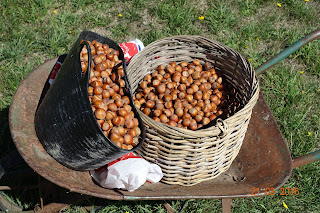My first Woofing experience in Australia this year. A Wwoof (Willing Workers on Organic Farms) host offers members the chance to visit and exchange their cultures while doing volunteer work for their food and accommodation. A chance to experience the real Australia, its people and way of life. Lasting friendship often arise from these visits. Some hosts I have visited on two or more occasions. The learning that occurs is truly amazing. Since 1999 I have visited more than 50 hosts in 6, or 7 countries. It is especially wonderful to find that one belongs to the same "tribe", talking the same language, sharing interests, outlook, likes, and other passions. Cherry Top was, for me, in the first rank. I was loath to leave. John and Lesley built the two houses on their farm themselves. Kevin McCloud and his programme "Grand Designs" inspired them to keep at it until they had built both properties with their own hands. Found materials, auctions and other sources kept the costs down. Now they have a thriving business in Lilydale, just north of Launceston, Tasmania, in an area of stunning scenery. A diverse range of produce from berries, apples, grapes, peaches, a bee hive, nuts pulses and vegetables from the farm and home cottage garden. Delightful vegetarian dishes of a cordon bleu standard had me salivating before each meal. Needless to say I have brought away a stack of recipes.
The Hunger Pot is very rare. Dating from the 1848 Irish Potato Famine. It was a time of mass starvation in Ireland, where the majority of people was solely reliant on this cheap crop. Approximately 1 million died and a further 1 million emigrated from Ireland. The Corn Laws, absentee landlords and land acquisition contributed largely to the humanitarian disaster. It became a rallying point for Home Rule and United Ireland movements. Laws that restricted Irish Catholics in the professions, education and land ownership. Huge food exports over this period are astonishing! Relief fundraising from India, Australia, the Pope and even from the Choctaw tribe in the USA.
The iron pot was set in many towns and was filled, thus making
sure everyone had a bowl of food daily. Land evictions, I need to add were part of the mix. Earl Lucan, (Lord Lucan's family), one of the worst offenders, evicted. He owned 64,000 acres.
John Gallagher is Irish by background.
Emily interviewed me for her YouTube page. http://youtu.be/Yr4jLVoXnLQ Going walkabout. Emily
The Hunger Pot is very rare. Dating from the 1848 Irish Potato Famine. It was a time of mass starvation in Ireland, where the majority of people was solely reliant on this cheap crop. Approximately 1 million died and a further 1 million emigrated from Ireland. The Corn Laws, absentee landlords and land acquisition contributed largely to the humanitarian disaster. It became a rallying point for Home Rule and United Ireland movements. Laws that restricted Irish Catholics in the professions, education and land ownership. Huge food exports over this period are astonishing! Relief fundraising from India, Australia, the Pope and even from the Choctaw tribe in the USA.
The iron pot was set in many towns and was filled, thus making
sure everyone had a bowl of food daily. Land evictions, I need to add were part of the mix. Earl Lucan, (Lord Lucan's family), one of the worst offenders, evicted. He owned 64,000 acres.
John Gallagher is Irish by background.
Emily interviewed me for her YouTube page. http://youtu.be/Yr4jLVoXnLQ Going walkabout. Emily
https://youtu.be/qxjGK-x7jHI
https://youtu.be/qxjGK-x7jHl
https://youtu.be/qxjGK-x7jHl
In the evening we had home made music. John and Emily,
who was also wwoofing at the same time as me
I picked lots of borloti beans, which I later removed them from their pods
Bottled peaches
Harvested Enis variety of hazel nuts
The farm tractor, a 1956 Fordson
Friday night was pizza night, with freshly pressed apple juice
A basket of peaches
The tree house, where I liked to have a mug of tea
The aroma of basil pervaded the kitchen garden
Apples ready to harvest
Huge organic chestnuts, with a fresh windfall every morning
A selection of veg and fruit for the farm shop
Every morning the chooks (Oz for chicken) would appear at my door
The windmill which pumped the water
A view from outside the door of my wooden sleeping cabin
Lovely fresh air and plentiful nature around my cabin
Medlar, the best tasting fruit you are unlikely to have heard of, looks like a giant hosehip
Roma tomatoes, especially good in Italian dishes and it is also blight resistant
John busy in the kitchen, wearing the traditional Melbourne chef's hat
Lesley about to serve up one of her vegetarian creations
Every evening a beautiful sunset would close another wonderful day
A huge iron Hunger Pot from the time of the Irish Potato Famine in the 1840's























































